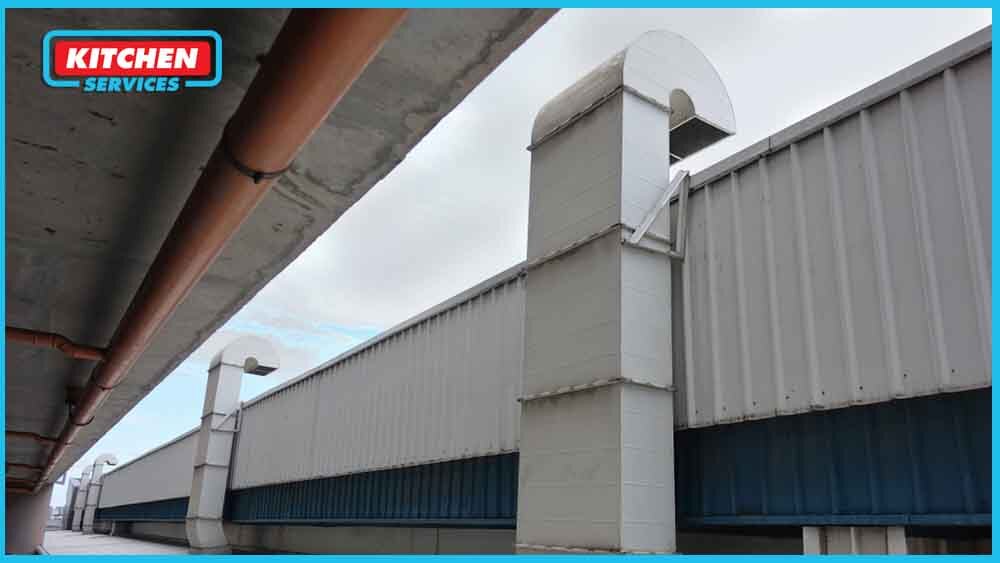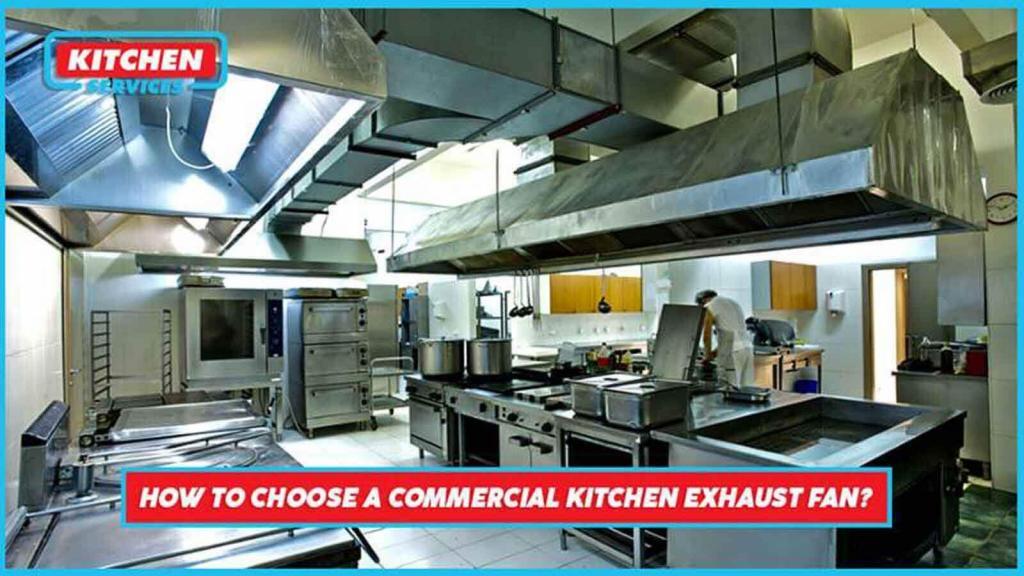For all restaurant workers and owners, getting the smoke, smell, and steam out of your kitchen is the top-most priority. The real question is: How? Well, the commercial kitchen exhaust fan is a significant piece of equipment for any restaurant kitchen. It is mechanical ventilation equipment that lets all your contaminated air present in the kitchen to pass out. Not only this, but it also brings clean air into the kitchen area. A commercial kitchen exhaust fan will eliminate flammable gums, smoke, and odor from the kitchen. The improved air quality is a necessity for all restaurants.

In addition to considering the safety system and unrestricted airflows, it is important to make the right choice in order to keep your kitchen ventilated. Our expert guide will help you in choosing the ideal fit of kitchen exhaust fan for your restaurant.
Types of Commercial Kitchen Exhaust Fan
Usually, commercial hood exhaust systems have two options of exhaust fan types to choose from. We have mentioned both for you so that it becomes easy for you to make a well-informed decision.
- Direct Drive Exhaust Fans: As the name suggests, the blades of these exhaust fans are directly joined to the motor’s shaft. These are a bit expensive and loud. However, they are proven to be more energy-efficient, easier to maintain, and clean as they come with very few movable parts.
- Belt Drive Exhaust Fans: This type does not have a direct connection of the motor with the fan blades. As compared to the first type, these are not that costly. The plus point of belt drive exhaust fans are that they are flexible when it comes to speed control adjustments and have a quieter functioning. However, this type may require frequent repairing as the friction between the belt and motor pulley creates a vibration that decreases the fan’s working efficiency.
Which Commercial Kitchen Exhaust Fan Is the Right Fit for My Kitchen?
A commercial kitchen exhaust fan installation is a must for your kitchen. Hence, before buying the right kind of exhaust fan, you need to give thought to it.
In order to know the right fit for your commercial kitchen, you need to consider some important things.
- Look for the placement area you choose.
- Check the airflow rate of an exhaust fan.
- Calculate its energy efficiency.
- Examine the static pressure.
Lets look at these aspects in detail.
Placement Area
Noise of your Commercial Kitchen Exhaust fan totally depends on the location of your exhaust fan, the noise that is generated by it may also be of a big concern. In case exhaust fan noise is a worry point for you, you will have to make sure that you check the sone rating on the fan even before you make a final purchase. In general, the higher the CFM, the higher the sone rating. Fan loudness is usually expressed in sones.
Air Flow Rate
If the air volume is concerned, the air velocity is always measured in linear feet per minute also said as LFM. It can be measured when the air passes through the duct. After that the LFM is multiplied by the volume of the duct in cubic feet to get a cubic feet per minute (CFM) measurement of air movement that is known as the air flow volume rate as well.
Normally, the exhaust hood that you will buy will also dictate what CFM your exhaust fan will need to be. All the factors that are affecting your hood choice may also include what type of cooking equipment you are using and the amount of cooking in your kitchen. For instance, a large area of open flame work cooking will need considerably more exhaust than the usual griddle or gas range will have to use.
The National Fire Protection Association (NFPA) 96 Standard for Ventilation Control and Fire Protection of Commercial Cooking Operations says that the air velocity through any duct shall not be less than 152.4 m/min (500 ft/min) and exhaust air volumes for hoods shall be of an adequate level to provide for capture and removal of grease-laden cooking vapors. So, lower exhaust air volumes are accepted during no-load cooking conditions as long as they are necessary to capture and remove flue gasses and residual vapors from cooking equipment.
Energy Efficiency
Basically the horsepower usually measures the power that is output by the motor that is there in your exhaust fan. Remember that one horsepower is equal to 746 watts in the International System of Units. The total amount of power that this motor will use is not entirely what it is capable of, but it really depends more on the manner in which it is first loaded. Comparable to any car’s engine, it is not the amount of power that the motor can deliver, but as a replacement for how much power is needed to do this work, or in the case of an exhaust fan, how much power is needed from the motor in order to spin the fan blades at a particular speed. Also motor power usage is directly related to the motor’s productivity.
Well the exhaust fans with a higher CFM will need more energy efficiency. All you need to do is to look at how much air is moved by the exhaust fan at the maximum expected operating static pressure and the fan’s energy efficiency rating. Finding the right combination of CFM and horsepower for your exhaust fan will help make sure your ventilation system operates efficiently and with fewer maintenance issues.
Static Pressure
First of all you must know what static pressure is, well static pressure is the resistance against air as it moves through your ventilation system. It also relates to the status of equilibrium in case the air supplied and the air exhausted are eventually equal. Also it is referred to the system air resistance or friction loss, the static pressure in a system directly relies on all parts that are working properly. Exhaust fans, ducts or filters if any of these elements are in deficiency, the entire system gets damaged.
Static pressure is usually measured by a manometer, which originally used a column of water in order to show the amount of static pressure. As the air pressure is increased, the column of water in the manometer would also rise. This is the reason that static pressure is still measured in inches of water. For any of your ventilation applications, it is expressed in inches per 100 feet of duct. One pound per square inch is equivalent to 27.7” psi and static pressure in exhaust fan systems is usually less than 2” psi, or 0.072 psi.
The major ventilation system components usually directly affect the static pressure and duct surface material as well as the length of the duct, duct system design, and the volume of air that is being pushed through. Getting an exact static pressure measurement might be critical in order to select the proper exhaust fan. But if your ductwork and exhaust systems are calculated properly, your system will run at its perfection. But in case the CFM of your commercial kitchen exhaust fan is very low, you are most likely to have poor circulation as well as air distribution. And in case the CFM of your fan is very high, your system will tend to create too much static pressure that will cause air and energy loss. If in any case the air in your system is meeting a lot of resistance, the static pressure would increase so with higher static pressure, you will encounter air loss and higher energy costs as well.
It would be better to consult a professional Kitchen Exhaust System installer in this regard as balancing the cost and your kitchen needs is a must in commercial hood systems.

Why is choosing the right commercial kitchen exhaust fan important?
It is really very important for you and all of your employees as well as the diners that you choose the right commercial kitchen hood system otherwise you will be putting everyone at risk. The properly installed commercial kitchen exhaust fan for all of your restaurants would help in keeping the air free of contaminants and it will also create a very comfortable environment for everyone that is present at that area. It is also very much important in order to reduce the fire risk of your commercial kitchen. It also slightly depends on a commercial kitchen or a residential kitchen, experts still highly recommend including an exhaust fan in any of your kitchen would be a better option.
It might not be as much fun as choosing the cooking appliances, but still it is very essential that your commercial kitchen exhaust hood be carefully matched to the operation of your kitchen.
Written down below are three main reasons that your commercial kitchen exhaust fan is important:
Fire suppression
In case you are using any cooking appliances that produce a lot of smoke and grease, in order to meet building codes you have to choose a commercial kitchen exhaust hood that has a fire suppression system.
Smoke, heat & grease removal
Other than meeting all these building codes, you still have to remove any kind of smoke for the health and safety purpose of your kitchen’s staff. Also you will want them to be able to see what they are actually doing in the kitchen also not to forget in case the smoke is not removed from the kitchen, it will ultimately transfer to your dining room, and you would never want that in any way.
Heat removal is also very important to the functioning of your kitchen and your staff. The last thing you need is workers passing out because the kitchen is terribly hot. So, removing grease is very much critical to prevent fire as well as cleanliness. Note that the grease that is not removed by your commercial kitchen exhaust hood will eventually settle on your kitchen surfaces. Which means your staff must spend more time cleaning.
Controlling odors
Another very essential function of your commercial kitchen exhaust hood is to keep cooking odors from spreading throughout your restaurant.
4 Things to Do Buying a Commercial Kitchen Exhaust Fan
Let’s explore the detailed guide we made for you on selecting kitchen exhaust fans.
- Choose Your Type: From the above-mentioned types, the first step is to know which type fulfills your needs. A lot of things will determine your preferences. For example, your budget, your cooking hours, etc.
- Setting Your Budget: You will get unlimited options to select from when visiting an exhaust hood depot. This is why setting a budget beforehand is always a wise thing to do. It will save you a lot of time by not having to go through very expensive options.
- Choose Placement Before Leaving: Don’t leave it for the last minute! You should be very sure when it comes to choosing the place for your commercial kitchen exhaust fan installation. Buying the ideal fit for your kitchen highly depends on the place you’ll be installing it.
Usually, kitchen exhaust fans are mounted on the wall, the rooftop, or the duct. Now each location demands different models and accessories.
- Measure Static Pressure: Before stepping out to purchase your commercial kitchen exhaust fan, it is crucial to measure the static pressure in your restaurant kitchen. It might get difficult for a layman to take accurate measurements, so it is advisable to call an HVAC professional for that matter.
A high CFM would mean energy wastage and air loss. On the other hand, low CFM indicates bad air circulation. Hence, purchasing an exhaust fan that fits your kitchen needs and its static pressure is essential.

